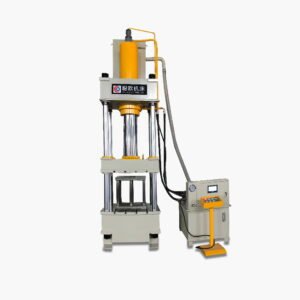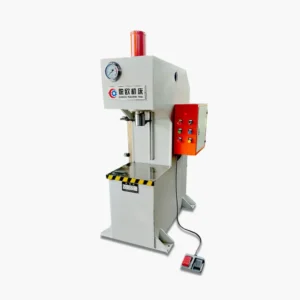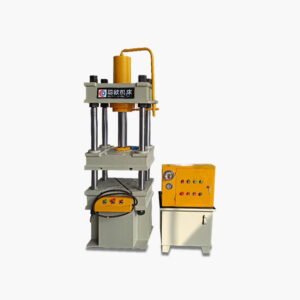DESCRIPTION OF HYDRAULIC PRESS WITH GANTRY FRAME DRIVE
Widely used for assembly and disassembly, hair straightening nozzle forming, perforating holes when pressing the button parts in electromechanical lines, also used for assembly and disassembly of intermediate shaft and shaft in automotive repair lines and used for shoveling, perforating holes, riveting eight wheels, and its necessary to push the button mechanisms in other lines.
In this hydraulic press series hydraulic presses are suitable for pressing process of plastic materials
Such as punching, bending, flanging and thin stretching, etc. It can also be used to fix, press the button,
Plastic products and products.
hydraulic system:
Hydraulic press system device – located on the right side of the press cartridge with integrated system, flexible solutions and reliable operation, good sealing. The hydraulic pump consists of an oil tank, a high-pressure engine pump, plug-in valves and other components.
CHARACTERISTICS OF PRODUCT
| Model | 20T | 40T | 63T | 100T |
|---|---|---|---|---|
| Nominal force | 200kN | 400kN | 630kN | 1000kN |
| Maximum pressure in the hydraulic system | 31.5Mpa | 31.5Mpa | 31.5Mpa | 31.5Mpa |
| Maximum opening distance | 560mm | 560mm | 560mm | 600mm |
| Slider stroke | 200mm | 200mm | 220mm | 220mm |
| Table dimensions (left to right* front to back) | 400*450mm | 400*500mm | 400*500mm | 550*600mm |
| Diameter of the plug hole | Φ60mm | Φ80mm | Φ100mm | Φ140mm |
How to choose a suitable hydraulic press for you?
<Eight Elements of Choosing a Hydraulic Press>
1、 Workbench size
The effective dimensions of the hydraulic press are: the distance between the left and right sides, and the distance between the front and back edges. The size of the workbench is determined based on the external dimensions of different products (molds). When a hydraulic press simultaneously presses (stretches) different sizes, it is determined based on the maximum size of the product (mold). In theory, the size of the product (mold) accounts for 70% -80% of the effective size of the workbench, and the specific situation is according to customer requirements.
2.Distance between the table and the slider
The opening size refers to the maximum distance from the top of the oil cylinder to the workbench. According to the different pressing (stretching) distances of different products, in order to maximize cost savings, it is sufficient to ensure a safety margin of 50MM-100MM remaining in the main cylinder of the pressing (stretching) product. It is also important to consider making it easier to remove the product after mold opening.
3、 Master cylinder stroke
The main cylinder stroke refers to the range of piston rod stroke, which should be less than the maximum stroke of the main cylinder to prevent damage to the cylinder.
4、 Mold height
The clamping height refers to the maximum opening height minus the stroke of the main cylinder. The clamping height should be less than the height of the product (mold) after molding. For example, if the opening height is 900MM, the stroke of the main cylinder is 600MM, and the clamping height is 300MM, that is, the height of the product (mold) should be greater than 300MM.
5、 Height of workbench above ground
Normal 600MM-750MM, with different requirements for different processes, the height above the ground plus the height of the product (mold) ensures safe and comfortable operation for workers.
6、 Working speed
The speed of hydraulic presses can be divided into slow, fast, and high-speed. The selection of speed depends on the product process.
7、 Action requirements
The actions are divided into: pressing and stretching, stretching products, and demolding processes, which require the installation of a top cylinder. The operation methods are divided into manual and automatic.
8、 Throat depth dimension
The throat depth dimension refers to the distance from the middle point of the hydraulic cylinder to the wall panel. The throat depth dimension is determined based on the size of the product (mold), and should be greater than the radius of the product (mold) to ensure that the center point of the product (mold) is perpendicular to the center point of the hydraulic cylinder when working on the hydraulic press workbench.









